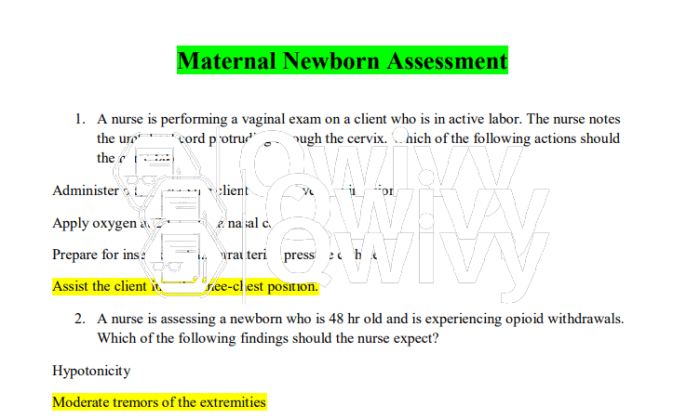The RN Vati Maternal Newborn Assessment is a comprehensive tool that empowers healthcare providers to assess the health and well-being of mothers and their newborns. This assessment plays a crucial role in identifying potential risks, promoting early intervention, and ensuring optimal outcomes for both patients.
This detailed guide delves into the components, implementation, documentation, and training aspects of the RN Vati Maternal Newborn Assessment. Healthcare providers will gain invaluable insights into its significance, components, and best practices for accurate and effective utilization.
RN Vati Maternal Newborn Assessment Overview
The RN Vati Maternal Newborn Assessment is a comprehensive tool designed to evaluate the health and well-being of both mothers and newborns during the postpartum period. It provides a standardized framework for healthcare providers to assess potential risks and complications, identify early signs of distress, and promote optimal outcomes for both patients.
The assessment is primarily used in hospital settings during the postpartum period, typically within the first 24-48 hours after delivery. It is particularly valuable in identifying and managing common postpartum complications such as postpartum hemorrhage, preeclampsia, and maternal infection.
By providing a systematic and comprehensive assessment, the RN Vati Maternal Newborn Assessment helps healthcare providers make informed decisions about the care and management of postpartum mothers and newborns, ultimately improving patient safety and promoting positive health outcomes.
Components of the RN Vati Maternal Newborn Assessment
The RN Vati Maternal Newborn Assessment consists of two main sections: the maternal assessment and the newborn assessment. Each section includes a range of specific components that are essential for a comprehensive evaluation of both the mother and the newborn.
Maternal Assessment
- Vital signs (temperature, pulse, respiration, blood pressure)
- Physical examination (fundal height, lochia, perineum, breasts)
- Psychosocial assessment (mood, anxiety, support system)
Newborn Assessment
- Apgar scoring
- Physical examination (head, neck, chest, abdomen, extremities)
- Neurobehavioral assessment (Brazelton Neonatal Behavioral Assessment Scale)
Maternal Assessment
The maternal assessment focuses on evaluating the physical and emotional health of the mother after delivery. It includes:
Vital Signs
Vital signs are essential indicators of the mother’s overall health and can help identify potential complications such as infection or hemorrhage.
Physical Examination
The physical examination assesses the mother’s reproductive organs, including the uterus, cervix, and perineum. It also includes an examination of the breasts to check for any signs of engorgement or infection.
Psychosocial Assessment
The psychosocial assessment evaluates the mother’s emotional well-being, including her mood, anxiety levels, and support system. This assessment is crucial for identifying potential mental health concerns, such as postpartum depression.
Newborn Assessment: Rn Vati Maternal Newborn Assessment

The newborn assessment focuses on evaluating the health and well-being of the newborn infant. It includes:
Apgar Scoring, Rn vati maternal newborn assessment
The Apgar score is a quick and standardized assessment of the newborn’s condition at birth. It evaluates five parameters: heart rate, respiratory effort, muscle tone, reflexes, and color.
Physical Examination
The physical examination assesses the newborn’s overall health and development. It includes a detailed examination of the head, neck, chest, abdomen, and extremities.
Neurobehavioral Assessment
The neurobehavioral assessment evaluates the newborn’s neurological and behavioral development. It includes a series of tests that assess the newborn’s reflexes, muscle tone, and social responsiveness.
Question Bank
What are the key components of the RN Vati Maternal Newborn Assessment?
The assessment includes maternal and newborn sections, covering vital signs, physical examination, psychosocial assessment, Apgar scoring, neurobehavioral assessment, and screening for congenital anomalies.
How does the RN Vati Maternal Newborn Assessment contribute to improving maternal and newborn outcomes?
The assessment enables early identification of potential risks, such as postpartum hemorrhage, preeclampsia, respiratory distress, and congenital anomalies. This facilitates timely intervention, improves outcomes, and reduces complications.
What are the best practices for documenting the RN Vati Maternal Newborn Assessment?
Accurate and timely documentation is crucial. Use electronic health records (EHRs) or other technologies to ensure legible, organized, and accessible records for effective communication among healthcare providers.